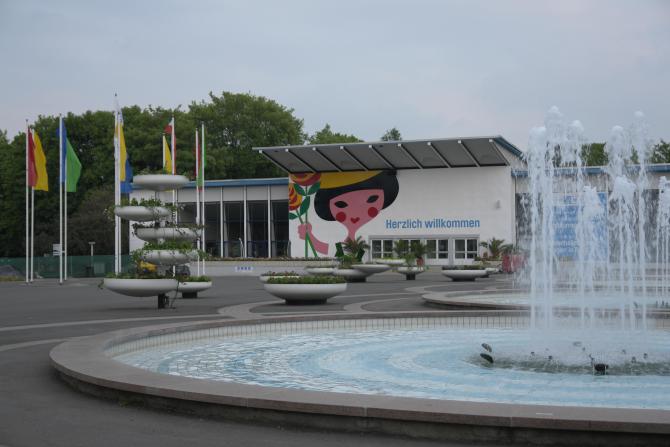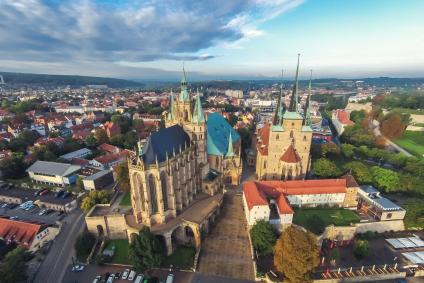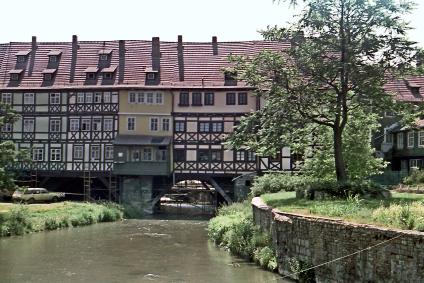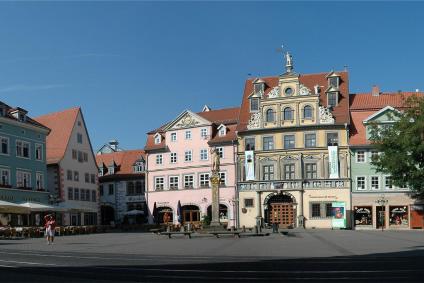The egapark ( eg : Erfurter Gartenbauausstellung) in Erfurt is one of the largest garden and leisure parks in Germany with an area of 36 hectares. The park area is located in the southwest of the city on the 265 meter high Cyriaksberg. Emerging from a former city fortress, the area was transformed from 1885 to public green space and further expanded in the subsequent period. After a first horticultural show in 1950, the largest and most important event of this kind took place in the GDR and in the socialist camp from 1961 with the regularly organized International Horticultural Exhibition (iga) .
The all-year-round, entry-level complex combines various exhibition halls, plant showhouses, themed gardens and relaxation areas. The main attractions in the egapark include, next to the 6000 square meters largest contiguous flowerbed in Europe, an observation tower, an observatory and the largest children's playground in Thuringia and the only horticultural museum in the country.
The park, which has been listed as a protected monument since 1992, is one of the major works of landscape architect Reinhold Lingner and is one of the most important testimonies of garden architecture in the 1960s in Germany. The Gartenschaugelände representing the long horticultural tradition of the "flower city" Erfurt was visited since 1961 by over 45 million guests. With an average of 450,000 visitors per year, the egapark - in addition to the Wartburg - is the most visited tourist attraction in Thuringia.
story
formation
With the founding of the German Reich in 1871 and the subsequent abolition of the fortress property of the city in 1873, the citadel Cyriaksburg lost its importance. The military use was severely restricted and parts of the city fortress were gradually demolished.
Nevertheless, the Erfurter Beautification Society, founded in 1841, achieved the release of areas of the site immediately adjacent to the fortress. Under his direction, the first plantings, paths and viewpoints were created in the summer of 1885, placed benches and made the resulting system publicly available. Primarily financed by donations, the association provided for the preservation and extension also in the further years.
With the end of the First World War in 1918 ended for the time being, the military use of the fortress. Then the city of Erfurt acquired on 24 April 1924 for 200,000 gold marks from the Prussian state the entire Cyriaksberg. Among other things, the purchase was accompanied by the obligation to preserve the former fortifications and to use them exclusively for public purposes. With the aim to create a recreation center for the growing urban population of the city, the work began in 1925. As a result, they were difficult, slowed down and became more expensive due to the inadequate quality of the soil. In addition, other fortifications such as the tower reduit, both corner batteries and the northern side caponniere were demolished. The execution took place partially in the context of the emergency program 1926/27 by unemployed.
After completion of the horticultural transformation in May 1928, the municipal green space was handed over to the public. In the 13.2-hectare park, the first rose and perennial gardens were found, and temporarily, a youth hostel was operated in remaining outbuildings of the fortress. In 1935, the southern former turret was converted into an observation tower for visitors, and the Waidmühle - still preserved today on the site - was reconstructed and set up for illustrative purposes.
Further planning, such as the planned alignment of the Reichsgartenschau in 1942 for the 1200th anniversary of the city, was thwarted by the beginning of the Second World War. The terrain was used again for military purposes. From 1943, the Wehrmacht stationed soldiers here, set up anti-aircraft guns on the towers and opened the vaults of the fortress as shelters for the civilian population. The condition of the site after the end of the war was correspondingly desolate, but in view of other wartime destruction subordinated.
1950-1960 Cultural Park Cyriaksburg
Already four months after the end of the war, the first regional garden show of the post-war period took place in Erfurt from 29th September to 14th October 1945, mainly in the Thüringenhalle. Under the slogan Kampf hunger , she was part of the simultaneous main exhibition Erfurt - economy under construction . As in the event that took place the following year, more food was created , focusing on self-sufficiency farming and improving the general supply situation. For both events, the management and organization was assigned to the landscape architect Gustav Allinger. However, the location proved to be only partially viable, so a relocation was considered.
In the course of the progressive reconstruction on 29 January 1948 the city administration under Lord Mayor Georg Boock decided to reconstruct the area around the Cyriaksburg with the goal to create a permanent exhibition area. The first construction work began in the spring of 1949 without state recognition and funding. The Potsdam landscape architect Walter Funcke (1907-1987) was responsible for the design, which was partly based on the design principles of the Reichsgartenschau 1939. In doing so, he maintained the basic structure of the pre-war park and supplemented functional routing and temporary exhibition architectures. The result was four exhibition halls, five model allotments, various sightseeing gardens and a Michurin garden. In addition to other design elements such as pavilions and four fountains, the early form of today's water axis, the two fortress towers were also integrated as a public observatory and vantage point.







